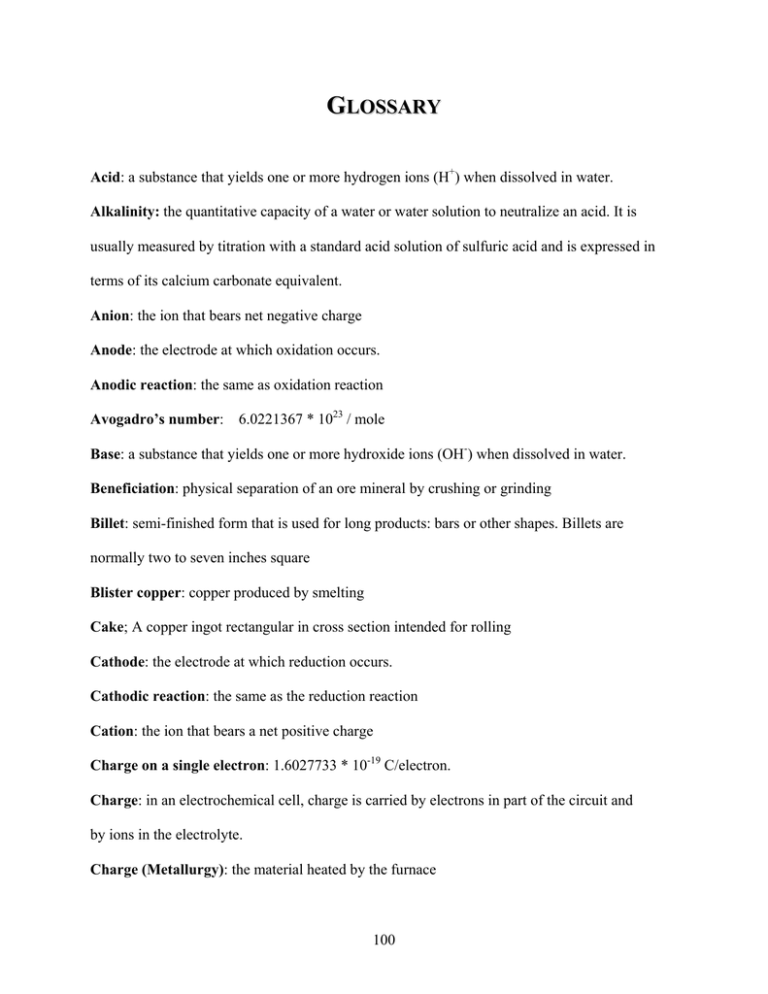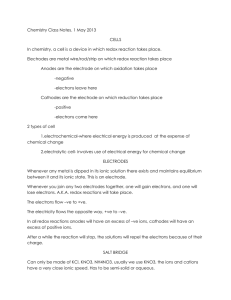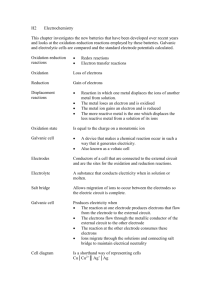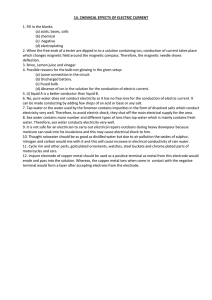G L O
advertisement

GLOSSARY Acid: a substance that yields one or more hydrogen ions (H+) when dissolved in water. Alkalinity: the quantitative capacity of a water or water solution to neutralize an acid. It is usually measured by titration with a standard acid solution of sulfuric acid and is expressed in terms of its calcium carbonate equivalent. Anion: the ion that bears net negative charge Anode: the electrode at which oxidation occurs. Anodic reaction: the same as oxidation reaction Avogadro’s number: 6.0221367 * 1023 / mole Base: a substance that yields one or more hydroxide ions (OH-) when dissolved in water. Beneficiation: physical separation of an ore mineral by crushing or grinding Billet: semi-finished form that is used for long products: bars or other shapes. Billets are normally two to seven inches square Blister copper: copper produced by smelting Cake; A copper ingot rectangular in cross section intended for rolling Cathode: the electrode at which reduction occurs. Cathodic reaction: the same as the reduction reaction Cation: the ion that bears a net positive charge Charge on a single electron: 1.6027733 * 10-19 C/electron. Charge: in an electrochemical cell, charge is carried by electrons in part of the circuit and by ions in the electrolyte. Charge (Metallurgy): the material heated by the furnace 100 Charging: the function of supplying a charge to a furnace Coke: basic fuel consumed in blast furnace in the smelting of iron. Coke is a processed form of coal Concentration cell: an electrolytic cell, the emf (electromotive force) of which is caused by a difference in the concentration of some component in the electrolyte (This formation leads to the formation of discrete cathode and anode regions). Conjoint analysis: a multivariate technique used to quantify the value that people associate with different levels of product/service attributes. Respondent trade product attributes against each other to establish product preference and the relative importance of attributes based on utility theory and consumer rationality Contingent valuation: to estimate economic values for all kinds of ecosystem and environmental services. CVM involves directly asking people, in a survey, how much they would be willing to pay for specific environmental services Coulomb: the quantity of electrical charge passing any point in the circuit in one second when the current is one ampere. 1 C = 1 A * 1s Electrical charge: Q = I (electrical current) * t (time) Electrochemical Reactions: chemical reactions in which electrons are transferred. Electrolysis: production of chemical changes in the electrolyte by the passage of current through an electrochemical cell. Electrical energy is used to run a nonspontaneous chemical reaction. Electrolyte (solution): a solution that contains ions. Electron: negatively charged particles in the nucleus. 101 Electrowinning (EW): concentration of one or more dissolved ions onto electrodes placed in a solution Equilibrium constants (K): product of the product activities divided by the product of the reactants activities, each raised to the power of their reaction stoichiometric coefficient Faraday: the charge carried by 1 mole of electrons. Film: a thin, not necessarily visible layer of material. Furnace: a chamber, enclosure, or other holding means for heating materials in. Gibbs free energy: thermodynamic function; also called free energy, free enthalpy, or Gibbs function Grain: an individual crystal in a polycrystalline metal or alloy Hard water: water which contains calcium or magnesium in an amount such that an excessive amount of soap is required in order to form lather. Hydrometallurgy: separation of a desired metal from an ore or concentrate by dissolution and later electrowinning (SX/EW) Inert anode: an anode that’s insoluble in the electrolyte under the conditions prevailing in the electrolysis Ingot: The casting obtained when molten metal is poured into a mold with the expectation that it be further processed. Ion: atom or group of atoms that has gained or lost one or more outer electrons and thus carries an electric charge. Positive ions, or cations, are deficient in outer electros. Negative ions, or anions, have an excess of outer electrons. Mdd: milligrams per square, if multiplied by 0.16, this becomes the expression in mils per year (mpy) 102 Molarity: way of expressing concentrations. Moles of solute per liter of solution. Neutron: subatomic particles which is not charged. NOM (Natural Organic Matter): organic matter originating from plants and animals present in natural (untreated or raw) waters, for example, in lakes, rivers and reservoirs Ore: mineral or an aggregate of minerals from which a valuable constituent, especially a metal can be profitably mined or extracted. Organic: any chemical compound based on a hydrocarbon chain or ring; where carbon shares electrons to create a strong (covalent) bond Oxidation reactions: half reactions which involve the loss of electrons. Electrons appear as products and explicitly. Passive: the state of a metal surface characterized by low corrosion rates in a potential region that is strongly oxidizing for the metal. pE: measure of redox potential, in other words, the negative logarithm of the electron activity. (p[red] – p[oxid] + pK) pH: A measure of the degree of acidity or alkalinity (basicity) of a solution; the negative logarithm of the hydrogen-ion activity. A value below 7.0 means increasing acidity and above 7.0 indicates increasing alkalinity (basicity), can be expressed as –log [H+]. Polarization: Deviation from the equilibrium potential or displacement of electrode potential resulting from a net current. The magnitude is measured in over-voltage with regard to the equilibrium potential of an electrode and usually denoted as h and the unit is volts or millivolts. Proton: positively charged particles in the nucleus. Pyrometallurgy: smelting processes based on thermal decomposition of ore minerals 103 Reaction quotient (Q): the same as the equilibrium constant expression, but for partial pressures or concentrations of the reactants and products before the system reaches equilibrium. If Q < K then the reaction is proceeding in the forward direction. If Q > K then the reaction is proceeding in the reverse direction. Redox potential: the potential of a reversible oxidation-reduction electrode measured with respect to a reference electrode, corrected to the hydrogen electrode, in a given electrolyte. Redox reaction: oxidation – reduction reactions. Oxidation and reduction always occur together because in any reaction the total number of electrons lost by the reducing agents must be equal to that gained by the oxidizing agents. Electrons appear implicitly. Reduction reactions: half reactions which involve the gain of electrons. Electrons appear as reactants and explicitly. Scale: a deposit of mineral solids on the interior surfaces of water lines and containers often formed when water containing the carbonates or bicarbonates of calcium and magnesium is heated. SHE: Standard Hydrogen Electrode; for a reduction reaction at an electrode when all solutes are 1 M and all gases are at 1 atm, the voltage is called the standard reduction potential. And the standard reduction potential of the hydrogen electrode is zero. The electrode itself is known as the standard hydrogen electrode. Slag: A more, or less completely fused and vitrified material separated during the reduction of a metal from its ore which generally floats on top of the molten metal during the heat reduction processes found in this class Soft water: water which contains little or no calcium or magnesium salts, or water from which scale-forming impurities have been removed or reduced. 104 Solvent extraction (SX) concentration of a desired element from a primary solution by dissolving in a smaller volume of a second solution that is mixed with the primary solution which separates as it’s immiscible. Tailings: waste material remaining after processes of making concentrate of the ore minerals. TDS: Total dissolved solids (TDS) comprise inorganic salts (principally calcium, magnesium, potassium, sodium, bicarbonates, chlorides and sulfates), some small amounts of organic matter that are dissolved in water, metals, cations, or anions. Thermodynamics: the scientific study of the inter-conversion of heat and other forms of energy. The first law of thermodynamics describes the conservation of energy; energy can be converted from one form to another, but cannot be created or destroyed. The second law is the entropy of the universe increases in a spontaneous process and remains unchanged in an equilibrium process. Tubercles: localized corrosion products scattered over the surface in the form of mounds. Valence: a whole positive or negative number representing the power of one element to combine with another. The valence number represents the number of electrons in an atom or combined group of atoms which can be easily given up or accepted in order to react with or bond to another atom or group of atoms to form a molecule. 105







